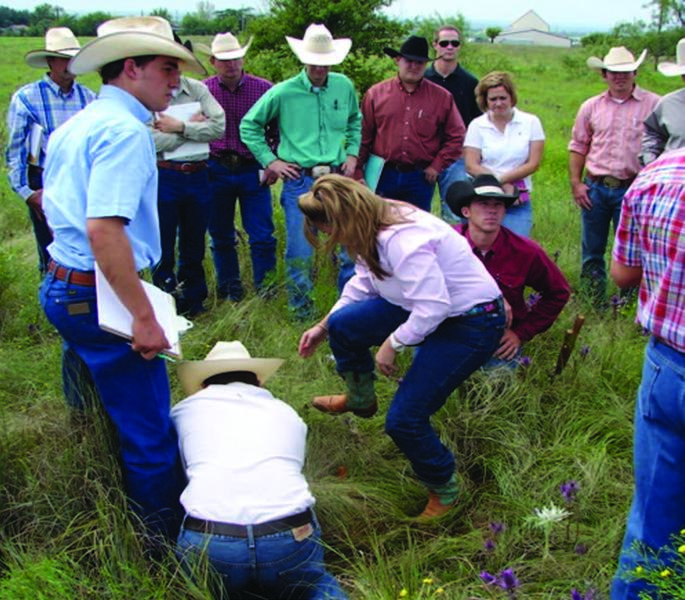
They wear cowboy hats. They rope outside of the Winthrop Rockefeller Building. But ranch management students are more than just cowboys. They are all-around Southern businessmen with a dress code, a code of conduct and a sound knowledge of all the ins and outs of the ranching industry.Jeffrey Geider, Director of the Institute of Ranch Management, said, “They learn how to manage the entire resource. They’re really business people learning business practices and principles as it applies to agricultural management.”Students pursuing a ranch management degree focus on the ecology and economics within the industry.Kerry Cornelius, Director of the Ranch Management Program said, “Conservation is a huge thing when you talk about ranch management. Because you always want to leave the environment better than you found it and better than when you started.”Resource conservationThe program is not just following the trend of going green. It has taught the value of conservation from its inception in 1955. The Ranch Management Program was founded with a goal of educating students on how to utilize and manage natural resources in a sustainable way.Today the program’s fundamentals include the management of soils, water, plants and animals alongside coures business courses such as marketing and finance.Each of the classes offered within the Ranch Management Program emphasize the importance of ecology. Soil and water conservation courses teach students plant and soil identification, characteristics, development and erosion. These skills help students identify problems and find solutions for the land in the future.”If you overstock your pasture what’s that do to you economically in the future? If you could figure out what moderation is and stock … to where you leave enough root system to where you maintain the integrity of the grasses and the productivity of the grasses then that is sustainable,” Cornelius said.Analyzing dataRanch management students inventory data about land to learn how correctly stock it with animals. Overstocking and overgrazing results in erosion. Students gather data from the Natural Resource Conservation Service, a web soil survey that includes information about ecological sites, rain and soil types, which are all crucial in the ranch planning process.Each site has different productive capabilities and capacities and students are taught to evaluate maps and make decisions based on the makeup of a particular piece of land.”If we erode the top soil away we lose thirty percent of our productivity and they know that it takes a thousand years to build an
inch of topsoil so we’re going to protect that topsoil at all costs,”Cornelius said. “Conservation is a huge thing when you talk aboutranch management. Because you always want to leave the environmentbetter than you found it and better than when you started.”A maverick propositionRanching is about productivity and maintaining a perpetual businesson top of stewarding land and caring for animals.”That’s one of the biggest reasons TCU Ranch Management is sounique and successful because we don’t teach you to be a specialistin one area. You have to know enough about all of it to make itwork,” Cornelius said.The Ranch Management Program at TCU is the only one of itskind in the state. The school has alumni from more than 40 statesand 22 countries.”TCU is the best place in the world to get a Ranch Managementdegree. There’s not another program like this one anywhere that Iknow of. There are some that try to copy, there are some that try todo other things but they don’t do the same thing we do. We teachthe practical application, business and economics of ranching,”Cornelius said.A different kind of educationThe program is unlike any other degree track at TCU. It offers afour-year Bachelor of Science degree, Bachelor of Arts and Bachelorof Science minor degrees as well as a certificate program.Thecertificate program is only two semesters long but the courseworkis very demanding.”It is equivalent to taking 56 hours worth of work in 2 semesters,”Cornelius said. “It can feel like you’re taking a drink out of a firehydrant.”The certificate program was founded by a group of ranchers inthat believed in a educating future ranchers from a holistic approachto managing agricultural resources rather than creatingspecialists in individual areas of the industry.In order to gain entrance into the program, students go through aninterview process. During their first two years, prospective studentstake core classes. Prior to their junior year, they must apply to theschool and then, upon acceptance, they students will also fulfill aminor in business. Ranch management majors take a full year ofonly ranch management classes. During their senior year, they arein class Monday through Friday from 9am to 4 pm. They take atotal of 2 classes per day and 7 classes per semester.While classroom time is important, 40 percent of the program is fieldtrips. Students have the opportunity to meet with professionals inthe industry and experience firsthand what ranch managers really do.”We take the students on five week-long field trips,” Corneliussaid. “We travel about 900 miles during the year and introducethem to about 68 professionals in the industry.”A world of opportunityGraduating students are not limited to working as ranch managers.Some become bankers, commodity brokers and insuranceagents while other go into real estate or oil and gas. The majorityof ranch management majors do become ranch managers suchas fjord managers, cow-calf managers, preconditioning managersand stocker operations managers.”We’re teaching business principles and practices that apply toany business. When they come out of here they’ve learned a lot.They’ve got a tremendous amount of confidence in what theyknow and how they’re going to tackle or meet certain challengesor expectations,” Cornelius said.Senior ranch management major, Taylor Marley, whose fatheris also a TCU ranch management graduate, plans to carry onhis family’s tradition of ranching and production agriculture.”We’ve learned a lot about the industry … how to run numbers,create budgets, look at markets and how to run a ranch at theoptimum level,” Marley said.Despite the grueling hours, Marley appreciated the program’sinstructional method.”The hours are long, your schedule is inflexible, but what youlearn in terms of experience and in the classroom makes it worthit,” Marley said.